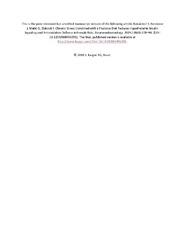Приказ основних података о документу
Chronic Stress Combined with a Fructose Diet Reduces Hypothalamic Insulin Signaling and Antioxidative Defense in Female Rats.
| dc.creator | Kovačević, Sanja | |
| dc.creator | Brkljačić, Jelena | |
| dc.creator | Matić, Gordana | |
| dc.creator | Elaković, Ivana | |
| dc.date | 2019-12-19 | |
| dc.date.accessioned | 2019-07-10T09:05:26Z | |
| dc.date.available | 2019-12-19 | |
| dc.date.issued | 2019 | |
| dc.identifier.uri | http://www.ncbi.nlm.nih.gov/pubmed/30572328 | |
| dc.identifier.uri | https://radar.ibiss.bg.ac.rs/handle/123456789/3387 | |
| dc.identifier.uri | https://radar.ibiss.bg.ac.rs/handle/123456789/3404 | |
| dc.description.abstract | BACKGROUND Increased fructose consumption and chronic exposure to stress have been associated with the development of obesity and insulin resistance. In the hypothalamus, a crossroad of stress responses and energy balance, insulin and glucocorticoids regulate the expression of orexigenic neuropeptides, neuropeptide Y (NPY) and agouti-related protein (AgRP), and anorexigenic neuropeptides, proopio-melanocortin (POMC) and cocaine- and amphetamine-regulated transcript (CART). OBJECTIVES We investigated whether chronic stress and fructose diet disrupt these hormonal signaling pathways and appetite control in the hypothalamus, contributing to the development of insulin resistance and obesity. Potential roles of hypothalamic inflammation and oxidative stress in the development of insulin resistance were also analyzed. METHODS Insulin, glucocorticoid, and leptin signaling, expression of orexigenic and anorexigenic neuropeptides, and antioxidative and inflammatory statuses in the whole hypothalamus of fructose-fed female rats exposed to unpredictable stress for 9 weeks were analyzed using quantitative PCR and Western blotting. RESULTS Chronic stress combined with a fructose-enriched diet reduced protein content and stimulatory phosphorylation of Akt kinase, and elevated 11β-hydroxysteroid dehydrogenase 1 and glucocorticoid receptor expression, while alterations in appetite regulation (NPY, AgRP, POMC, CART, leptin receptor, and SOCS3 expression) were not observed. The expression of antioxidative defense enzymes (mitochondrial manganese superoxide dismutase 2, glutathione reductase, and catalase) and proinflammatory cytokines (IL-1β, IL-6, and TNFα) was reduced. CONCLUSIONS Our results underline the combination of long-term stress exposure and fructose overconsumption as more detrimental for hypothalamic function than for either of the factors separately, as it enhanced glucocorticoid and impaired insulin signaling, antioxidative -defense, and inflammatory responses of this homeostasis- regulating center. | en |
| dc.relation | info:eu-repo/grantAgreement/MESTD/Integrated and Interdisciplinary Research (IIR or III)/41009/RS// | |
| dc.relation | SCOPES JRP IZ73Z0_152331 | |
| dc.rights | embargoedAccess | |
| dc.source | Neuroendocrinology | |
| dc.subject | Appetite | |
| dc.subject | Female rats | |
| dc.subject | Glucocorticoid receptors | |
| dc.subject | Inflammation | |
| dc.subject | Insulin | |
| dc.subject | Leptin | |
| dc.title | Chronic Stress Combined with a Fructose Diet Reduces Hypothalamic Insulin Signaling and Antioxidative Defense in Female Rats. | en |
| dc.type | article | en |
| dc.rights.license | ARR | |
| dcterms.abstract | Несторов, Јелена; Ковачевић, Сања; Елаковић, Ивана; Матић, Гордана; | |
| dc.rights.holder | © 2018 S. Karger AG, Basel. | |
| dc.description.note | This is the peer-reviewed but unedited manuscript version of the following article: Kovačević S, Nestorov J, Matić G, Elaković I. Chronic Stress Combined with a Fructose Diet Reduces Hypothalamic Insulin Signaling and Antioxidative Defense in Female Rats. Neuroendocrinology. 2019;108(4):278–90. (DOI: 10.1159/000496391). The final, published version is available at [http://www.karger.com/?doi=10.1159/000496391]] | |
| dc.identifier.doi | 10.1159/000496391 | |
| dc.identifier.pmid | 30572328 | |
| dc.identifier.scopus | 2-s2.0-85067413293 | |
| dc.identifier.wos | 000471962300002 | |
| dc.citation.apa | Kovačević, S., Nestorov, J., Matić, G., & Elaković, I. (2019). Chronic Stress Combined with a Fructose Diet Reduces Hypothalamic Insulin Signaling and Antioxidative Defense in Female Rats. Neuroendocrinology, 108(4), 278–290. | |
| dc.citation.vancouver | Kovačević S, Nestorov J, Matić G, Elaković I. Chronic Stress Combined with a Fructose Diet Reduces Hypothalamic Insulin Signaling and Antioxidative Defense in Female Rats. Neuroendocrinology. 2019;108(4):278–90. | |
| dc.type.version | acceptedVersion | |
| dc.identifier.fulltext | https://radar.ibiss.bg.ac.rs/bitstream/id/5189/bitstream_5189.pdf | |
| dc.citation.rank | aM21 |

